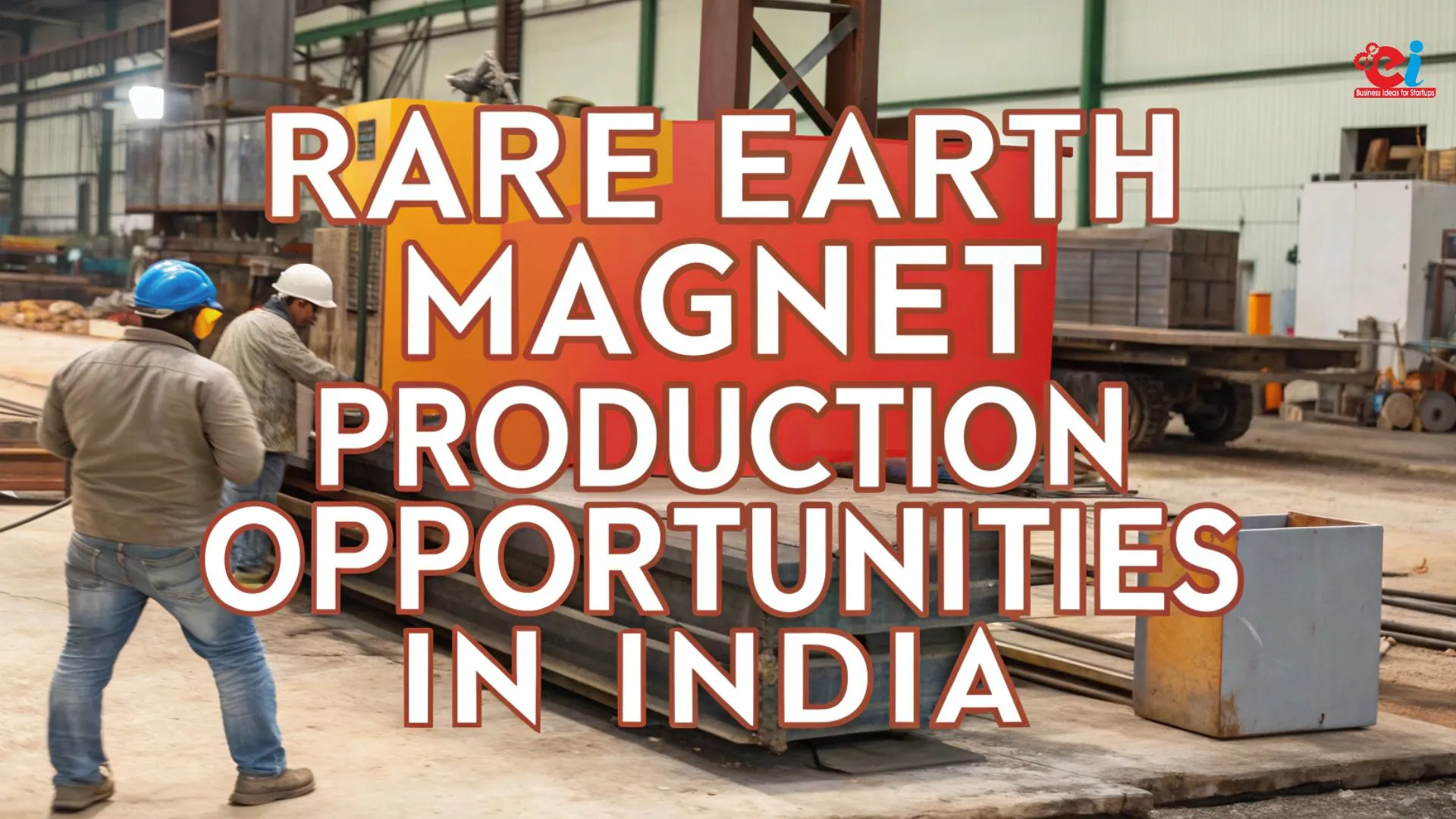India is at an important point in its evolution as an industrialist country. With the demand in the world for green energy, electric vehicles, and high-performance electronics increases and rare earth magnet are emerging as essential components across all industries. As a major policy change in the last few years, it is now the Government of India is now actively encouraging private sector participation in the manufacturing of rare earth metals. This is a great chance for entrepreneurs and startups to get into the manufacturing industry, supported by the national strategic goals.
Understanding Rare Earth Magnet and Their Importance
Rare earth magnets (also known as which are primarily Neodymium-ironboron (NdFeB) magnets) are well-known for their magnetic strength and efficacy. They are essential to various applications like wind turbine generators as well as electric vehicle motors, drones as well as medical imaging devices, mobile phones, as well as aerospace systems. As the world shifts towards green technology, the rare earth magnet is rapidly replacing traditional magnets due to their advantages in performance.
Market Potential and Growth Forecast
According to market research from around the world, the market for rare earth magnets is predicted to expand at a rate of more than 7.5 percent between 2024 to 2030. India is the fifth largest manufacturer of rare earth elements (REE) and has a huge untapped potential. The government’s efforts to promote Atmanirbhar Bharat and production-linked incentive (PLI) plans further increase the potential for the country’s rare earth magnet production.
The market for NdFeB magnets alone is predicted to be around the USD 25 billion mark by 2030, with India likely to take an important portion because of its efforts to promote EVs and renewable energy.
Related: Rare Earth Magnet Production in India: A Strategic Opportunity for Entrepreneurs
Government Initiatives and Policy Support
On July 20, 2025, the Union Minister G. Kishan Reddy announced plans to increase the number of private players in the field of rare earth magnet production, which indicates a pivotal shift from the export of raw ore towards value-added production of magnets. Reforms to the policy framework are in process to remove regulatory obstacles and provide land support via industrial corridors and to facilitate access to the latest manufacturing technologies through global collaborations. This is in line with India’s energy independence long term as well as crucial minerals strategy.
Key Industries Driving Demand
- Electric Vehicle (EV) Manufacturing
- Renewable Energy (Wind Turbines)
- Consumer Electronics
- Aerospace and Defense
- Medical Equipment (MRI Machines)
- Robotics and Automation
These industries are seeing massive investments and policy incentives, which makes rare earth magnets an excellent business opportunity.
Outline of Rare Earth Magnet Manufacturing Process
- Raw Material Processing: Rare earth oxides that are extracted are separated and cleaned.
- Alloy Preparation: The elements neodymium, iron and boron are heated in furnaces that use vacuum to create alloys.
- Powder Metallurgy: The alloy gets crushed to fine powder, then it is aligned magnetically.
- Pressing and Sintering: Powders are compressed into the desired shape and then burned at high temperatures.
- Machining, Coating and Cutting: Magnets are cut, ground and then coated to stop corrosion.
- Magnetization and Testing: Final magnetization is performed using powerful magnetic fields, followed by quality tests.
Related: Understanding Rare Earth Alloys for Product Development
Challenges and Barriers to Entry
Although the market is promising, entrepreneurs should be ready for capital costs, technological complexity, supply chain volatility for critical inputs, and strict environmental regulations. However, through strategic partnerships and feasibility planning, these challenges are reduced.
How NPCS Can Help You Enter the Rare Earth Magnet Sector
Niir Project Consultancy Services (NPCS) provides detailed Market Survey as well as technological economic Feasibility Reports for setting up new manufacturing units and industries. Our reports include the entire manufacturing process, the raw materials needed, plant layout plans, as well as comprehensive financials.
If you’re an entrepreneur or an investor, NPCS assists in assessing the financial and technical potential for the rare earth magnet manufacturing company, giving you clarity and certainty in your investment choice.
The industry of rare earth magnets in India is poised to undergo transformational growth. With government incentives, growing market demand, and abundant mineral resources, India has begun to become a major manufacturing hub. Entrepreneurs who embrace the national vision early will not only gain financially but also aid in India’s self-reliance in key technology. With the help of a skilled advisor and a thorough plan, manufacturing of rare earth magnets will become a key element in India’s future industrial development.
Global Context and India’s Competitive Edge
Globally, countries such as China dominate the rare earth value chain with more than 80 percent of the world’s demand for rare earth resources. However, increasing tensions between the two countries and the increasing emphasis on diversification of supply chains have drawn the attention of international authorities to alternative hubs such as India, Australia, and the USA.
India is home to the fifth-largest reserves of rare earth elements, mostly in states like Odisha, Andhra Pradesh, Kerala, and Tamil Nadu. The Indian Rare Earths Limited (IREL), under the Department of Atomic Energy, has played an important role in rare earth extraction.
India’s enormous reserves, low-cost skilled workers, and strong engineering foundation give it a competitive edge to be a leading source of magnets made of rare earth.
Supply Chain and Raw Material Sourcing
Manufacturing rare earth magnets is extremely resource-intensive and requires a reliable supply chain. The primary rare earths used in magnet production are neodymium (Nd), praseodymium (Pr), dysprosium (Dy), and terbium (Tb). These are typically created from bastnaesite and monazite ore.
India’s coastal states hold huge monazite sand reserves, processed by IREL and other authorized miners. To secure raw materials, the government supports joint ventures and long-term offtake contracts with friendly countries. This reduces import dependence and ensures steady feedstock for domestic magnet producers.
Technology Trends and Innovation Opportunities
Modern technology is revolutionizing rare earth magnet production. Innovations such as grain boundary diffusion, nano-structured magnetics, and the recycling of end-of-life magnets are making production more efficient and sustainable.
Indian startups and MSMEs can benefit from:
- Technology transfer
- R&D collaboration with CSIR laboratories
- Government-funded innovation hubs
Additionally, the development of indigenous sintering furnaces, powder processing equipment, and magnetic alignment tools will lower CAPEX and improve production efficiency.
Export Potential and Global Demand
India’s strategic location and FTAs with ASEAN and African countries offer significant export benefits. Countries like Japan, South Korea, Germany, and the US are seeking to diversify their rare earth supply chains, particularly for magnet-grade items.
With a robust quality control system and competitive pricing, Indian manufacturers can meet global demand. It is estimated that India’s rare earth magnet export potential could exceed USD 3 billion annually by 2030, driven by global EV mandates, wind power expansion, and next-gen electronics.
Business Models for Entrepreneurs
Entrepreneurs may adopt different models to enter the industry:
- Integrated Manufacturing Unit: From raw material processing to finished magnet production.
- Component Provider: Supplies sintered blocks, magnetic assemblies, or bonded magnets to OEMs.
- Recycle and Reuse: Processes used magnets from EVs and electronics.
- Contract Manufacturing: Works with large manufacturers under license or tolling agreements.
Each model carries distinct risks and investment profiles. NPCS helps entrepreneurs choose the best structure based on location, capital, and market access.
Skill Development and Employment Generation
Rare earth magnet manufacturing is labor-intensive in its early stages, especially during powder metallurgy, assembly, and testing. A 500 MT/year plant could create over 200 direct jobs and 500+ indirect jobs in logistics, R&D, maintenance, and supply chain management.
Skill development through ITIs, engineering colleges, and Skill India missions can help bridge the workforce gap. Specialized training programs are also being created under the Critical Minerals initiative.
Financial Viability Snapshot
Establishing a rare earth magnet manufacturing facility requires CAPEX and OPEX planning.
Estimated Project Cost for a 500 MT/annum Plant:
- Land and Building: ?10 Crore
- Machinery & Equipment: ?45 Crore
- Utilities & Installation: ?8 Crore
- Working Capital: ?12 Crore
- Miscellaneous Expenses: ?5 Crore
Total Estimated Cost: ?80 Crore (Approx.)
Expected ROI: 18–22%
Payback Period: 4–5 years
For more information check related video about this topic
Role of Niir Project Consultancy Services (NPCS)
Niir Project Consultancy Services (NPCS) offers full-scale guidance to entrepreneurs, MSMEs, and industrialists exploring rare earth magnet manufacturing.
Our Reports Include:
- Process flow details and plant layout
- Equipment and supplier selection
- Raw material sourcing strategy
- Market benchmarking and demand analysis
- Complete financial projections and ROI evaluation
With 45+ years of experience and 50,000+ clients globally, NPCS ensures technically sound, risk-mitigated, and profitable industrial setups.
Final Thoughts on Rare Earth Magnet
The rare earth magnet industry in India is no longer just a dream—it is a national priority. Entrepreneurs who take the lead in this high-demand sector will benefit from first-mover advantages, government support, and global access.
With the right strategy, timely investment, and guidance from NPCS, rare earth magnet manufacturing in India can grow into a globally competitive industry.
Now is the time to act—not just for profit, but to help shape India’s future in critical minerals.






